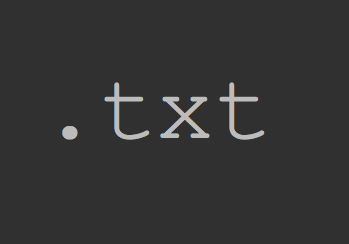There is something about writing or logging your day in text files that is quite different from writing in a Microsoft Word Document, Apple Pages Document, Google Document, or even an OpenOffice ODT format. Below we will show you why geeks love plain text files and why you should too.
Portability
One of the best things about plain text is that it is a portable format between almost any operating system that I have seen. You can use plain text files on Windows, Mac OS, iOS, Android, Windows Phone, Linux, etc. All of these operating systems have ways of natively showing you the contents of a text file as well and also allowing you to edit its contents. It’s safe to say that 20 years from now most operating systems (at their core) will be able to open a plain text file making your data safe and
Easy To use
Plain text files are at the zenith of ease of use. There isn’t really anything to learn; you just start typing text into a blank file. That’s it. No keyboard shortcuts to learn, or complicated menu structures, or ways to format etc. It’s all about putting data in a file and that is it. You can create a new plain text file simply in any operating system with built in apps (ie. TextEdit.app or Notepad.exe), or if you are a real *nix geek just be typing something as simple as: touch my_new_text_file.txt Then open that sucker up in vim and type away (Don’t forgot to shift-z-z every once in a while to save, you nerd!). It couldn’t be simpler to get your thoughts down with a plain text file as the tool. The best part about ease of use is that text files allow you to write, not fiddle with your tools. There are of course apps out there that allow you too mess around with your setup, but if you want to get some writing done a plain, no-frills text editor allows you to start writing right away.
No lock-in
Another great reason that geeks love plain text is that there is no vendor lock-in. This goes hand-in-hand with the portability reason mentioned above. There is no “special app” that only supports text files. There is no “compatibility issues” that you need to deal with (I’m looking at you, Microsoft Word). For all purposes, text files are just text files and can be opened by pretty much any document or text creation software. This is a great thing when you want your data sticking around for the long term. When the .doc format dies in the next 80 years, it would be hard for me to believe that some system that exists in the world won’t be able to open the simplest of data forms (even if you have to load it up in your heads-up-display that is embedded in your eyes).
Good for almost anything
I use the word almost with care. I haven’t found too many things in my writing and developer journeys that plain text files aren’t good for, except one thing. Non-linear thinking (ie. mindmapping). Text files aren’t very good at connecting non-linear ideas together in an easy way. I’m sure that it is possible, but I haven’t found a good way to do it when I need to brainstorm. This is one of the only things when it comes to writing that I don’t use plain text for. The good thing about mindmapping, at least with any mindmapping applications that are worth a damn, is that you can export your data to an OPML format which is pretty portable as it is XML markup. You can open XML in any text editor as plain text.
Awesome apps for text creation and editing
Here are some of the best apps that I have found for creating, manipulating, and using your plain text files:
Dropbox (Windows, Mac, Linux) BBEdit (Mac) Notepad++ (Windows) vim (Windows, Mac, Linux) TextEdit (Mac) Notepad.exe (Windows) Byword (Mac) Notesy (iOS) Epistle (Android) SimpleNote (Web)
Plain text files are easy, portable, searchable, and aren’t locked to a specific technology. Not to mention you will be nerdy and cool when you use plain text (just ask Mike). So, if you are looking to keep your words and data around for a long time, look to us geeks for some advice. Use plain text.
